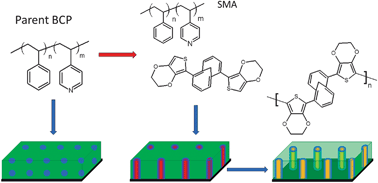Block copolymer supramolecular assembly using a precursor to a novel conjugated polymer†
Abstract

* Corresponding authors
a
Department of Chemistry and Biochemistry, University of the Sciences, Philadelphia, PA 19104, USA
E-mail:
a.sidorenko@usciences.edu
Tel: +1 (215) 596 8836
b Department of Chemistry, Johns Hopkins University, Baltimore, MD 21218, USA
c Integrated Imaging Center, Department of Biology, Johns Hopkins University, Baltimore, MD 21218, USA

 Please wait while we load your content...
Something went wrong. Try again?
Please wait while we load your content...
Something went wrong. Try again?
D. Hagaman, J. Gredzik, P. A. Peart, J. M. McCaffery, J. D. Tovar and A. Sidorenko, Polym. Chem., 2013, 4, 1482 DOI: 10.1039/C2PY20680C
To request permission to reproduce material from this article, please go to the Copyright Clearance Center request page.
If you are an author contributing to an RSC publication, you do not need to request permission provided correct acknowledgement is given.
If you are the author of this article, you do not need to request permission to reproduce figures and diagrams provided correct acknowledgement is given. If you want to reproduce the whole article in a third-party publication (excluding your thesis/dissertation for which permission is not required) please go to the Copyright Clearance Center request page.
Read more about how to correctly acknowledge RSC content.
 Fetching data from CrossRef.
Fetching data from CrossRef.
This may take some time to load.
Loading related content
